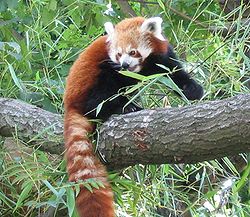Ailuridae
Aspect
| Ailuridae Fosilă: oligocen–prezent | |
|---|---|

| |
| Panda roșu | |
| Clasificare științifică | |
| Regn: | Animalia |
| Încrengătură: | Chordata |
| Clasă: | Mammalia |
| Ordin: | Carnivora |
| Subordin: | Caniformia |
| Infraordin: | Arctoidea |
| Suprafamilie: | Musteloidea |
| Familie: | Ailuridae Gray, 1843 |
| Genuri | |
|
Actiocyon (†) | |

| |
| arealul pandei roșii | |
| Modifică text |
|

Ailuridae este o familie de mamifere carnivore mici, care are în componență doar un membru: Ailurus fulgens sau panda roșu.
Caracteristici generale
[modificare | modificare sursă]- Are o lungime de 50 cm;
- Are o greutate de 3 kg;
- Are o blană roșie
Răspândire
[modificare | modificare sursă]Este răspândit în India și Nepal.
Membri
[modificare | modificare sursă]- Ailurus fulgens (panda rosu)
Specii fosile
[modificare | modificare sursă]Familia Ailuridae conține și opt genuri extincte, majoritatea din ele incluse în subfamiliile Ailurinae și Simocyoninae.[1][2][3][4][5]
- Familia Ailuridae
- Genul Protursus (†)
- Protursus simpsoni
- ?Subfamilia Amphictinae
- Subfamilia Simocyoninae (†)
- Genul Alopecocyon (†)
- Alopecocyon leardi
- Genul Simocyon (†)
- Simocyon batalleri
- Simocyon diaphorus
- Simocyon hungaricus
- Simocyon primigenius
- Genul Alopecocyon (†)
- Subfamilia Ailurinae
- Genul Magerictis (†)
- Magerictis imperialensis
- Genul Pristinailurus (†)
- Pristinailurus bristoli
- Genul Parailurus (†)
- Parailurus sp.
- Parailurus hungaricus
- Parailurus anglicus
- Genul Ailurus
- Ailurus fulgens – panda roșu
- Genul Magerictis (†)
- Genul Protursus (†)
Referințe
[modificare | modificare sursă]- ^ McKenna, MC & Bell SK (). Classification of Mammals Above the Species Level. Columbia University Press.
- ^ Peigné, S., M. Salesa, M. Antón, and J. Morales (). „Ailurid carnivoran mammal Simocyon from the late Miocene of Spain and the systematics of the genus”. Acta Palaeontologica Polonica. 50: 219–238.
- ^ Salesa, M., M. Antón, S. Peigné, and J. Morales (). „Evidence of a false thumb in a fossil carnivore clarifies the evolution of pandas”. Proceedings of the National Academy of Sciences. 103 (2): 379–382. doi:10.1073/pnas.0504899102. PMC 1326154
 . PMID 16387860.
. PMID 16387860.
- ^ Wallace, SC & Wang, X (). „Two new carnivores from an unusual late Tertiary forest biota in eastern North Americ”. Nature. 431 (7008): 556–559. doi:10.1038/nature02819. PMID 15457257.
- ^ Ailuridae (în engleză), www.helsinki.fi
Lectură suplimentară
[modificare | modificare sursă]- Davis, Davis D. (1964). “The Giant Panda: A Morphological Study of Evolutionary Mechanisms.“ Zoology Memoirs. Vol. 3:1-339.
- Decker D.M. and W.C. Wozencraft. (1991). “Phylogenetic Analysis of Recent Procyonid Genera.“ Journal of Mammalogy. Vol. 72 (1): 42-55.
- Flynn, J.J. and G.D. Wesley Hunt. (2005a). “Carnivora.“ in The Rise of Placental Mammals: Origin, Timing and Relationships of the Major Extant Clades, by D. Archibold and K. Rose. Baltimore. ISBN 0-8018-8022-X
- Flynn, John J., et al. (2005b). “Molecular phylogeny of the Carnivora (Mammalia): ASS-ASS the impact of increased sampling to on resolving enigmatic relationships.“ Systematic Biology. Vol. 54 (2):1-21. [1] Arhivat în , la Wayback Machine.
- Flynn, John J. Flynn, Michael A. Nedbal, J.W. Dragoo, and R.L. Honeycutt. (1998) "Whence the Red Panda?" Molecular Phylogenetics and Evolution. Vol. 17, No. 2, November 2000, pp. 190–199. [2]
- Glatston, A.R. (1989). Talk Panda Biology. The Hague. ISBN 90-5103-026-6
- Glatston, A.R. (compiler) (1994). “The Red Panda, Olingos, Coatis, Raccoons, and their Relatives: Status survey and conservation action plan for Procyonids and Ailurids.”
- IUCN/SSC Mustelid, Viverrid, and Procyonid Specialist Group. IUCN/SSC, Gland, Switzerland.
- Gregory, W.K. (1936). “On the Phylogenetic Relationships of the Giant Panda (Ailuropoda) to other Arctoid Carnivores.“ American Museum Novitates. Vol. 878:1-29.
- Hu, J.C. (1990). “Proceedings of studies of the red panda.” Chinese Scientific Publishing, Beijing, China [în chineză].[3]
- Wilson, Don E. and DeeAnn M. Reeder. (2005). Mammal of Species of the World. Johns Hopkins University press. ISBN 0-8018-8221-4.
